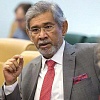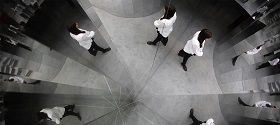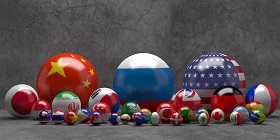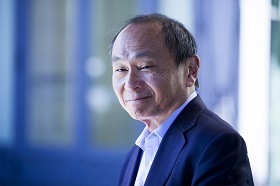What is “hybrid power”? In the days of the Vietnam war, the Vietnamese leadership described its strategy as “politico-military-diplomatic”, by which they meant an organically integrated, fused, multifaceted, multidimensional, hybrid strategy. It is such a holistic or total strategy that enabled them to wage People’s War as Total War. This of course was the strategy that enabled the USSR to prevail in the Great Patriotic War. As such, I would define hybrid power as the capacity of generating such an organically integrated holistic politico-military-diplomatic strategy and implementing it globally.
It is a forgotten fact that Russia used to have two parallel apparatuses—the official state apparatus including the Foreign Ministry, originally the Comintern (the centenary of whose founding was forgotten), then the Cominform, and more durably the International Department of the Communist Party of the Soviet Union as well as the party’s many auxiliary bodies—all of which had international counterparts and linkages, constituting a transcontinental matrix. While the Foreign Ministry operated in the system of states, maintaining state-to-state relations, the Communist party apparatus enabled not only party-to-party relations but a whole other dimension of movements. While state-to-state relations must operate within a global status quo, the party-to-party and movement dimensions operated at a societal level and one of political struggle. This phenomenon occurred within the status quo, influencing it in some situations, but generating, leveraging or adapting to the dynamics of change in other situations.
When the West treats the modern Russian state, be it Soviet or post-Soviet, as an adversary, a hostile entity, as evidenced by the movement of military forces, the exit from arms control agreements, and a reversion to the most ruthless Cold War doctrines such as ‘rollback’ and ‘first strike’/‘war-fighting, war-winning’, the Russian state has little reason to divest itself of its modern intellectual and political patrimony, turning its back on the political, philosophical, ideological, intellectual, doctrinal, conceptual armaments of the Soviet state and the Soviet period. In the contemporary context, the project of post-Soviet Russian Realism needs a selective, critical reintegration of elements of Soviet thought, updating and upgrading them as befits the 21st century. There is no other path to the (re)generation of ‘hybrid power’.
What is “hybrid power”? In the days of the Vietnam war, the Vietnamese leadership described its strategy as “politico-military-diplomatic”, by which they meant an organically integrated, fused, multifaceted, multidimensional, hybrid strategy. It is such a holistic or total strategy that enabled them to wage People’s War as Total War. This of course was the strategy that enabled the USSR to prevail in the Great Patriotic War. As such, I would define hybrid power as the capacity of generating such an organically integrated holistic politico-military-diplomatic strategy and implementing it globally.
It is a forgotten fact that Russia used to have two parallel apparatuses—the official state apparatus including the Foreign Ministry, originally the Comintern (the centenary of whose founding was forgotten), then the Cominform, and more durably the International Department of the Communist Party of the Soviet Union as well as the party’s many auxiliary bodies—all of which had international counterparts and linkages, constituting a transcontinental matrix. While the Foreign Ministry operated in the system of states, maintaining state-to-state relations, the Communist party apparatus enabled not only party-to-party relations but a whole other dimension of movements. While state-to-state relations must operate within a global status quo, the party-to-party and movement dimensions operated at a societal level and one of political struggle. This phenomenon occurred within the status quo, influencing it in some situations, but generating, leveraging or adapting to the dynamics of change in other situations.
It was Antonio Gramsci who broadened our vision from an exclusive focus on the fortress of the State to that of the complex network of trenches of civil society, arguing that moral, intellectual, ethical and cultural hegemony—as distinct from domination—fought for and established precisely on the plane of civil society, was the only guarantee of prevailing over the enemy. Prof. Joseph Nye’s ‘soft power’ is an unacknowledged, much belated, and greatly oversimplified derivative of Gramscian ‘hegemony’.
A drastic demolition of an earlier network of trenches and apparatuses of para-state nature has given rise to a deficit of “hybrid power”. This has proved to be an obstacle for the Russian State in the face of its adversary, who is seeking to deprive them of the geopolitical and geostrategic space commensurate with Russia’s weight, role, self-respect and existential drives and needs. Meanwhile, the idealistic illusions of the “Doves of Détente” remain embedded in the complex network of trenches that Gramsci spoke of, and seem to be the dominant paradigm and discourse—sometimes manifest, sometimes latent- of the intelligentsia’s policy.
The dismantling of the 1990s meant the abolition of the political dimension of the “hybrid power” apparatus, which served Russia’s foreign policy interests, and also had a global reach right into the rear areas, as it were, of the adversaries’ societies. It was a unilateral disarmament in the field of political power and a distinct disadvantage in the arena of hybrid politico-military contestation. To give a dramatic illustration, 90 years ago, perhaps the finest text of hybrid warfare was co-authored in Moscow, and published under the collective pseudonym of A. Neuberg. It was co-authored by Tukhachevsky, Ho Chi Minh, Pianitsky and Wollenberg, with Togliatti as editor. Today, the Movement/radical change dimension is the sole preserve of the West, and is a powerful tool in its hybrid warfare strategy, over which it has a monopoly.
This absence of a parallel political-ideological track, especially one designed for catalyzing or accelerating change, means that a holistic doctrine or philosophy of world politics must pick up the slack. One strand of this would most certainly be the ideas of Yevgeny Primakov, which would however, have to be both contextualized and developed. The Primakovian contribution was the praxis of the double transition, from the Soviet to the post-Soviet and from unipolarity to multipolarity. However, this transition is now in a new stage characterized on the one hand by the end of Russia’s unilateral retreat and the drawing of Russian ‘red lines’ of resistance, and on the other, by the global strategic offensive posture of the US-led Western power, the advance of NATO to Russia’s borders, the open designation of Russia as an adversary and the attempt to encircle the Eurasian heartland states.
The tasks of this new stage require that the Primakovian perspective be developed, and this can be done only by intellectual fidelity and a return to the actual roots of the Primakovian idea: A Realist re-reading and creative application of the best of Leninist and Soviet thinking, while being liberated from its Procrustean frame. It was said of Marx that he used Hegel’s method but not his system, liberating the former from the latter. This was true of Primakov and the Leninist, Soviet and world Communist intellectual heritage: he extracted the method and set aside the obsolete system of thought. It would be inadequate to rely solely on the Primakovian perspective, and the larger matrix of Russian Realism must be rediscovered and revived as the paradigm of world politics today.
Russian realists tend to blame a dilettantish liberalism for the deviation from the great tradition of Western Realism, from Kennan to Kissinger, which they are familiar with. Russian thinking, while understandably rejecting the liberal idealism of Fukuyama et al, has tightly embraced an American or Western Realism, that of Kissinger and Huntington, when a far richer and authentic strand of Russian Realism exists, submerged in the history of the modern Russian State and its strategic politico-military thought. This latter realism is connected to an even larger matrix of Eurasian Realism, of which a good illustration is the difference between the responses of Dr. Kissinger and his counterpart, Vietnam’s Le Duc Tho, in the Paris Peace Talks, when they were jointly awarded the Nobel Peace Prize. Dr Kissinger accepted, while Le Duc Tho, the Asian Leninist, politely declined, declaring that “so long as there is imperialism, there will be war”. Who then was the better realist, and which, the Western or the Eurasian, was the better realism?
It is a conventionally held belief that “ideology” leads to “idealism” while the further one gets from ideology the closer one approaches or embraces realism. However, the texture of actual history is rather different. There have been periods in which ideology went hand in hand with realism and other periods when it was twinned with idealism, and still other periods when it approximated neorealism. There are also periods in which there was a maximum deviation from or abandonment of one ideology only to embrace another, perhaps opposite ideology—and such periods exhibit the maximum characteristics of idealism rather than realism. Still more complicated are the periods of transition when within a period of ideology and idealism, there are influential individuals—Primakov inevitably comes to mind—who represent the strand of realism or neorealism.
In conventional reconstructions, the Leninist period is seen as one of ideology and therefore of idealism, even utopianism. The Stalinist period is seen, by contrast, as one of realism. The Khrushchevite period is once again seen as a time of idealism, while the post-Khrushchev period is labeled as one of welcome return to realism. The period of High Détente in the 1970s is seen as the acme of realism. I would question this periodization and propose a rather different periodization and classification.
It is often forgotten, but is hardly an accident that one of the founding fathers of modern realism in international relations, EH Carr, was also the historian of the Russian Revolution and a sympathizer of the Soviet experiment. There was neither anomaly nor contradiction between his realism and his abiding interest in the history of the Russian Revolution, and between the Soviet state and the history of the Comintern and Cominform. For EH Carr, the history and policy of the Russian Revolution in its internal and external dimensions was not the polar opposite, the antinomy, of the realism that he espoused. His abiding interest and treatment of the subject showed that for Carr, the policy of the Russian revolution and the Soviet state was either a version and variant of realism—a radical Realism—or a combination a synthesis of realism and idealism, of power structures and the normative factor, amounting to what would be later termed Neorealism, albeit a leftwing Neorealism.
EH Carr noted the realism of Lenin’s insistence on the signing of the Brest-Litovsk at the time he did, so as to prevent further collapse and further inroads by the Germans. Indeed, the resistance from the Left Bolsheviks and the hesitancy of Trotsky cost Russia considerable territory until the Treaty was signed. But EH Carr’s main emphasis was the turn to Realism proper by Lenin in the last years of his life, especially in 1920, following the defeat of the Red Army offensive into Poland. This defeat and Lenin’s shift to the NEP, marked the proper onset of Soviet Realism, which was solidified by Stalin. Carr’s work on the Comintern and the Spanish Civil War as well as the Cominform, traced the militant Realism of the Soviet leadership, fighting against right wing and leftwing idealisms but occasionally committing those very errors.
The development and deterioration of US-Russia and US-China relations should prompt a revaluation of categories and periods. I suggest that the post-Stalin period of modern Russian history be seen as a period which was dominated not by a turn to a consistent Realism, but by the dominance of idealism, which was misunderstood as realism. Indeed, I would argue that the tendency of Realism in the post-Stalin period was brief and often subject to political and ideological defeat. That realist tendency, which was more realist than its opponent, was misperceived as both ideological and idealist, as a left deviation, while its victorious opponent was seen as Realist, when in reality—and the pun is intended—it proved to be far more idealist than its defeated opponent. One may see a predominant period of idealism and a suppressed realism according to today’s perspective on the matter, which requires revaluation and rehabilitation, if one is to face the challenges of the current moment in world history.
The delusions of the 20th Congress dated back to the period immediately following the Great Patriotic War but were brought out into the open and combated in the denunciation of the idea of a prolonged postwar alliance with the US as over-optimistically foreseen by the leader of the US Communist party, Earl Browder. This line was criticized in the famous Duclos Letter (1945), penned by the head of the French Communist Party, Jacques Duclos. The international line of the newly created Cominform as articulated by Zhdanov, and the diplomatic interventions by Vishinsky were the landmarks of the post WWII realism of the Stalin leadership, which, following his death, were represented by Molotov and Kaganovich. This line was characterized by the constant awareness of the possibility of armed confrontation with the West, initiated by the West.
At no time did the Stalin leadership assume that the creation of atomic and nuclear weapons diminished this possibility. Nor was it even considered that the factor of nuclear weapons should mean that the possessors of those weapons, the USA and Russia, should establish a privileged relationship transcending the two camps; one in which the outreach to the US should be more important to Russia than the new relationship with the victorious revolution in the world’s most populous state, China. The post-Stalin ouster of Molotov and Kaganovich led to the dramatic change of the international and strategic thinking of the Russian leadership. The perceived need to address the issue of nuclear weapons led to the privileging of the equation with the West on the part of the post-Stalin leadership. It was this turn that was one of the major factors in the Sino-Soviet rift.
Little noticed, but most important from the perspective of the strategic analyst though, is the first phase and leading personality of Realism in the post-Stalin period. I wish to suggest that the line of the most important Realist figure of this period was the most correct perspective available to the Soviet (and Russian) leadership in the post-Stalin period, and had it been adopted, the Soviet Union may well have remained intact and the present situation of encirclement of Eurasia may have been avoided. This unsung Russian Realist hero is Alexander Shelepin. Shelepin’s misgivings about the policy of détente vis-a vis the USA have been validated. The optimism of his opponents has been dispelled and disproved by the subsequent trajectory. Shelepin’s critics, the ones who prevailed in the inner-party struggle, may have been tactically, conjuncturally and episodically correct; but they have been proved strategically and historically wrong. Their chain of conceptual error and ideological illusion has to be dealt with.
It is time to recognize that contrary to conventional wisdom, the real Russian Realists were the so-called “hardliners” or “hawks”—I would call them lucid warriors—not the “doves” of Détente. These individuals include Shelepin, Andropov, Grechko, Gorshkov, Ustinov, Orgarkov, and Akhromyev. History has validated their clarity, skepticism and tough-minded Realism. It is their strategic perspectives and policies that when taken together, constitute the New Realist paradigm necessary to combat the global offensive and the long-term secular trend—whatever the US administration—of a tightening encirclement from Arctic to Indo-Pacific, of Eurasia’s heartland.
When the West treats the modern Russian state, be it Soviet or post-Soviet, as an adversary, a hostile entity, as evidenced by the movement of military forces, the exit from arms control agreements, and a reversion to the most ruthless Cold War doctrines such as ‘rollback’ and ‘first strike’/‘war-fighting, war-winning’, the Russian state has little reason to divest itself of its modern intellectual and political patrimony, turning its back on the political, philosophical, ideological, intellectual, doctrinal, conceptual armaments of the Soviet state and the Soviet period. In the contemporary context, the project of post-Soviet Russian Realism needs a selective, critical reintegration of elements of Soviet thought, updating and upgrading them as befits the 21st century. There is no other path to the (re)generation of ‘hybrid power’.
This article reflects the personal views of the Author.








